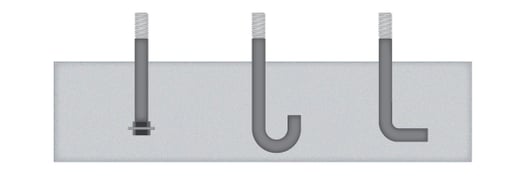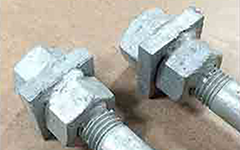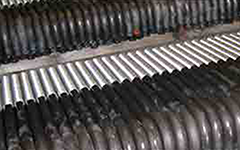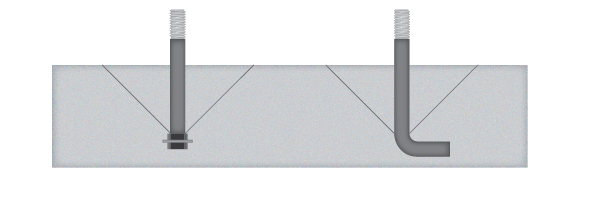Headed vs. Hooked Anchor Bolts: Is there a difference? Which should you use?
In recent years, there has been a shift in preference by the AISC and ACI between headed and hooked anchor bolts. It's important that fabricators and engineers are aware of this trend, and why it has occurred.
Most steel fabricators are familiar with the difference between headed anchor bolts and hooked anchor bolts. If you’re not, the diagram below will help to show the difference.

Headed anchor bolts are straight with a load bearing member attached by thread to the embedded end, which usually takes the form of either a hex nut or a plate washer positioned in between two hex nuts.
Hooked anchor bolts are curved on the embedded end of the bolt, and the protrusion that this curvature creates acts as the load bearing member for the entire bolt.
 .
. 
(Headed) (Hooked)
In the past, the steel fabrication industry had a preference to use hooked anchor bolts in steel erection projects. In recent years, however, the trend has changed, with most plans calling for headed anchor bolts for the same projects.
The major reason for this shift is that both the AISC and ACI have provided guidance to all engineers that headed anchor bolts should be used in place of hooked anchor bolts whenever possible. Why is this the case?
A successfully embedded anchor bolt will form a breakout cone with the concrete. In the diagram below, this cone is shown. By forming the breakout cone, tensile strength is distributed between both the anchor bolt and its concrete member, and typically it is designed so that the concrete will fail before affecting the anchor bolt.

This breakout cone cannot form, however, if the bond between the anchor bolt and the concrete is not formed, or is broken, which brings us to the difference between headed and hooked bolts.
Studies comparing the two styles of anchor bolt (headed and hooked) have shown that there is a significant decrease in the pullout strength of hooked anchor bolts as compared to headed bolts. Pullout strength is the force required to pull the anchor bolt out of its concrete member without substantially damaging the concrete. Pullout strength is not typically calculated to find the maximum force required to pull the anchor bolt entirely out of the concrete, but to find the minimum force required to compromise the bond between the anchor bolt and the concrete.
The pullout strength calculation is different for headed and hooked anchor bolts. This is due to the inner curvature of a hooked anchor bolt, which compromises the bond between the anchor bolt and the concrete at a greater rate under tension. Below are the formulas used to determine the nominal pullout strength for both types of anchor bolts.
Headed Anchor Bolt
Nominal Pullout Strength = 8 * Area of the Load Bearing Member * Concrete Strength
Hooked Anchor Bolt
Nominal Pullout Strength = 0.9 * Concrete Strength * Distance From the Inner Edge of the Bolt to the Outer Tip * Bolt Diameter
The constant in both equations shows how much less pullout strength a hooked anchor bolt can provide. Whereas the constant for a headed anchor bolt is 8, the constant for a hooked anchor bolt is 0.9. Additionally, the nominal pullout strength of a headed anchor bolt only needs to factor the area of the load bearing member and the concrete strength. In comparison, the nominal pullout strength for a hooked anchor bolt is a factor of concrete strength, bolt diameter, and length of the hook.
In conclusion, while many architects, engineers and steel fabricators still choose to use hooked anchor bolts, The Steel Supply Company would generally recommend the usage of a headed anchor bolt in most situations. However, The Steel Supply Company is a manufacturer and does not employ engineers. So if an engineer requires the usage of one over the other, we defer to them. In all cases, the plans and drawings should be adhered to.
Please get in touch with any questions regarding your steel fabrication needs.




